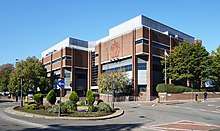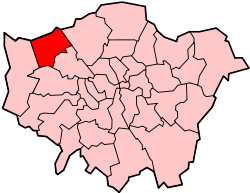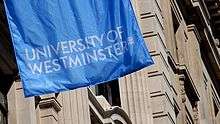Harrow, London
Harrow (/ˈhæroʊ/[2]) is a large town in Greater London, England and serves as the principal settlement of the London Borough of Harrow. Lying about 10.5 miles (16.9 km) northwest of Charing Cross and 5.4 miles (8.7 km) south of Watford, the entire town including its localities Harrow on the Hill, Harrow Weald, Headstone, North Harrow, Kenton, Rayners Lane, South Harrow, Wealdstone and West Harrow, had a population of 149,246 as of the 2011 census, whereas the wider borough had a population of 250,149.
| Harrow | |
|---|---|
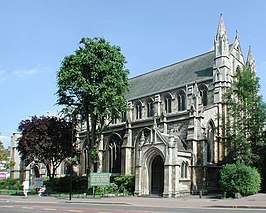 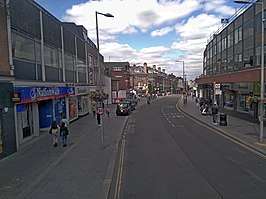 From top to bottom: St John the Baptist, Greenhill church; Station Road in the town centre | |
 Harrow Location within Greater London | |
| Population | 149,246 (2011 Census)[1] |
| Demonym | Harrovian |
| OS grid reference | TQ145885 |
| • Charing Cross | 11 mi (18 km) ESE |
| London borough | |
| Ceremonial county | Greater London |
| Region | |
| Country | England |
| Sovereign state | United Kingdom |
| Post town | Harrow |
| Postcode district | HA1, HA2, HA3 |
| Dialling code | 020 |
| Police | Metropolitan |
| Fire | London |
| Ambulance | London |
| UK Parliament | |
| London Assembly | |
Historically in Middlesex, Harrow was a municipal borough before it became a part of Greater London in 1965. The modern town of Harrow is what was historically called Greenhill, a former hamlet at the foot of the 408 feet (124 m) Harrow Hill settlement. With the arrival of the Metropolitan Railway in the 19th century, the centre of Harrow moved to Greenhill[3] and it grew as the unofficial "capital" of the Metro-land suburbia.[4] The historic centre of Harrow, often distinguished as Harrow on the Hill, is a conservation area with listed buildings of Georgian architecture and home to the famous Harrow School. The modern-day town of Harrow is an established commercial centre of outer North West London.[5]
Etymology
Harrow's name comes from Old English hearg = "(heathen) temple", which was probably on the hill of Harrow, where St. Mary's Church stands today.[6] The name has been studied in detail by Keith Briggs.[7]
The original Greenhill hamlet derived its name from the hollow (which has been built over from the 19th century) to the north of Harrow Hill. It was not recorded in the Domesday Book but was mentioned as early as 1334 as "Grenehulle". In addition, one or more families bearing the "Greenhulle" or "Greenhill" surname lived there from at least 1247, and are likely to have taken their name from this location.[8] The name "Greenhill" survives and the local council has continued the name by using it for "Greenhill Way" a road which by-passes the mainly-pedestrianised and modernised shopping area based around College Road and St Anns Road. The name is also still used for the local electoral ward.
It is possible that Greenhill went by an even older name, Norbury, c. 1300, but the hamlet of Norbury has not been identified with certainty as of yet. The name may have been correspondent to Sudbury, being north of what was then Harrow Hill.[8]
History

Harrow, formerly known as Greenhill, was a small hamlet of farms at the foot of Harrow Hill. For almost a millennium, the centre of Harrow was atop the hill, but this started to change in the 19th century. Circa 1852, the village had 8 houses, 17 cottages, and one inn, with 141 people.[8]
Urban development
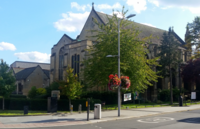
By 1865, a series of roads had been built in Greenhill, including College, Roxborough, Kymberley, Headstone, Clarendon, Byron and St Anns - but few houses.[10] A parish church, St John's Church, was built in 1866 on a farm and Greenhill became a separate parish in 1896. The church building has been Grade II listed since 1994.[11] The Metropolitan Railway came in 1880 with the building of Harrow-on-the-Hill station, which led to a housebuilding boom[12] and a population reaching 4,892 by 1902.[13] Developments westward along the railway in the Headstone and Pinner as well as Roxborough and Wealdstone engulfed Greenhill with new developments, and soon enough there was nothing left og the original village.[10]
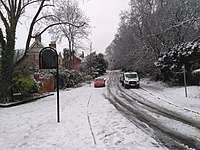
In 1899, the junction of Grove Hill and Lowlands Road is said to have been the scene of the country's first fatal car accident.[14]
In Greenhill, there was a workmen's club from the 1860s and a public hall, Victoria Hall, by 1888.[15]
By 1895, most of Greenhill (along with Roxeth) became part of the Harrow on the Hill Urban District, while a small part in the north became part of Wealdstone Urban District. It would remain so until 1934.[15]
One of the oldest surviving buildings in what is today Harrow is the Grade I listed Headstone Manor from the 15th century.
Harrow contributed to the growing photographic industry in the UK; a large industrial premises was built in 1890 by the American Eastman Kodak company in Wealdstone, and by 1965 there were over 100 buildings on a 55-acre site, employing 5,500 people.[16]
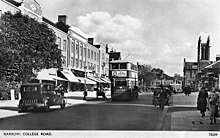
In 1914, a major department store named Sopers opened on Station Road. The site is now a Debenhams store;[17] its current facade dates from the 1960s.[18]
During the inter-war period Harrow had grown into a suburb.[19] Almost two-thirds of housing stock in the present day Borough of Harrow dates back to the interwar period.[18]
Railway accidents
The modern town of Harrow and much of the borough overall has been defined by the railways as Harrow grew out of the Metropolitan Railway, and today has several train stations; Harrow has a history of train accidents.[20]
On 7 August 1838, Thomas Port died from injuries received in a train accident near Harrow. His gravestone in the parish churchyard of St Mary's, Harrow-on-the-Hill, states: "To the memory of Thomas Port, son of John Port of Burton-upon-Trent in the County of Stafford, Hat Manufacturer, who near this town had both legs severed from his body by the railway train. With great fortitude, he bore a second amputation by the surgeons and died from loss of blood, August 7th 1838, aged 33 years."
On 26 November 1870, two trains collided at Harrow & Wealdstone station, killing 9 and injuring 44.[21]
On 8 October 1952, three trains collided at Harrow & Wealdstone station, killing 112 people.[22] Of the dead, 64 were railway employees on their way to work.
Battle of Britain
Although The Blitz is generally claimed to have started on 7 September 1940, many sources state that one of the earliest bombing raid from the Luftwaffe occurred in Harrow and Wealdstone on 22 August 1940. It caused damage to cinemas, houses and a bank, but with no fatalities.[23] Although Harrow was then in Middlesex, it was classed as a London area by the civil defence as it came under the jurisdiction of the Metropolitan Police.[24] The very first air raid on the present day London area is believed to be the accidental bombing of Croydon Airport on 15 August 1940, which was then in Surrey.[23]
Post-war
The town was part of the Harrow Urban District, a district council within the county of Middlesex, from 1934 until 1965, which also included parts of Edgware, Hendon, Wembley and Pinner. The London Borough of Harrow was formed in 1965 as the only London borough unaffected by boundary changes.[16]
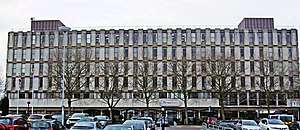

By the 1950s, Harrow was described as the "capital city of Metro-land".[25] The borough's council Civic Centre building complex was built in 1970–1972, opened 6 May 1973, on Station Road in Wealdstone.[26] Six storeys high and designed by architect Eric Broughton, the building has a typical concrete style of the time[27] Throughout the 1960s and 1970s many new office blocks were built in the town, especially in Lyon Road and the western end of College Road.[18]
.jpg)
The town underwent regeneration in the 1980s with the building of a bus station in College Road and the pedestrianisation of St Anns Road. A statue called "Skipping Katie" was unveiled by the local council in May 1987 to celebrate the completion of the pedestrianisation. The landmark was designed by James Butler inspired by watching his daughter skip.[28] A plaque on Katie was unveiled in 2004 by Queen Elizabeth II and the Duke of Edinburgh to mark the 50th anniversary of the London Borough of Harrow.[28]
In the autumn of 1987, Princess Diana visited Harrow, where she officially opened the new St Anns shopping centre amid a large crowd of locals.[29] Located opposite the central train station on College Road, the centre was built on demolished buildings including Heathfield School for Girls, which moved away to Pinner in 1982.[30]
Nearby St Anns shopping centre, another indoor retail outlet was built which was opened as St George's Shopping and Leisure Centre on St George's Day in 1996. The town's Woolworths store on Station Road closed and was replaced by a new branch inside St George's.[30][31] Other landmarks built during the decade include the Hygeia building in 1991,[32] which has an erected golden coloured sculpture facing the bus station. Furthermore in 1991, Lower Mead stadium on Station Road, the home of Wealdstone F.C., was sold to Tesco and demolished. In its place a new large Tesco superstore was built.[33][34]
21st century
The town centre is undergoing a new wave of redevelopment. In 2011 the one-way single lane section of Station Road was widened to allow two-way bus traffic.[35] The 11 storey luxury apartments of Bradstowe House was completed in 2016 after long delays.[36] Former office buildings on Lyon Road (including Coal House, once belonging to the National Coal Board) have been regenerated into new mixed use buildings in the 2010s,[37] whereas on Pinner Road behind St George's centre a new eight storey development called Trident Point was built which includes a large Morrisons supermarket opened in 2013.[38] The former post office sorting building on College Road, next to the train station, remained vacant for some years until plans for a 19-storey skyscraper was approved by the council in 2015. The development, called Harrow Square, was partly completed with 318 apartments across four buildings in 2018.[39][40] It includes a bottom floor 1,450 square metres (15,600 sq ft) library still under construction which will replace the current Gayton Library on St John's Road.[41][42] The building next to it, formerly First National House,[43] has been refurbished into luxury apartments called The Hub.[44]
The borough received a £1 million grant from the Mayor of London that will go towards a new public square and a "pop-up test eatery" at the site of the former Cumberland Hotel on Lyon Road, expected to be completed by 2020.[45] The 1930s art deco facade of the Safari Cinema, which has been hidden since the 1960s, is set to be restored from 2020.[46][47] The council aims to invest over a billion in the town centres of Harrow and Wealdstone and the Station Road corridor in between.[48]
Geography
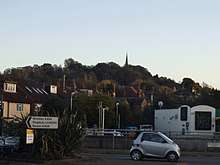
The borough of Harrow overall has a leafy, suburban character, much of which is a legacy of it being at the centre of the Metroland developments of the early 20th century.[49]
The town centre is about 220 feet (67 m) above sea level, almost 200 feet (61 m) below the top of Harrow Hill, which is an outlying knoll.[50] The hill is half a mile south of the town centre, and the settlement is rich with historic architecture and has a village atmosphere.[51] The steep climb towards the hill is clearly visible from Lowlands Road. Other parts of Harrow are not as affluent but are still mostly leafy, particularly the northern part called Harrow Weald. The rural northern slopes of Harrow, around Harrow Weald Common, are part of the Green Belt and contain a conservation area[52] and a Site of Special Scientific Interest (SSSI) adjacent to another SSSI called Bentley Priory Nature Reserve which comes under Stanmore. The area also has the highest elevation in Harrow, as high as 492 feet (150 m) above sea level.

There is also agricultural land close by the town, on fields at the eastern side of Harrow on the Hill, on Watford Road. This open farmland is only half a mile away from Harrow's town centre and is adjacent to Northwick Park Hospital and Northwick Park open space. The farm borders Harrow Park and other open spaces and golf courses that are within Harrow on the Hill; other open spaces include: The Grove open space and Harrow Recreation Ground near the town centre; West Harrow Recreation Ground; Kenton Recreation Ground; Alexandra Park in South Harrow; Newton Park in Rayners Lane; Byron Recreation Ground in Wealdstone; and the grounds of Headstone Manor.
Much of Kenton, and before 1716 all of Pinner, were parts of Harrow. Today Pinner forms a separate district within the borough of Harrow. Harrow Weald is the district north of Wealdstone, and both of these are historically also part of Harrow. Today Harrow is the principal settlement of the London Borough of Harrow, which also includes the towns of Pinner and Stanmore.
The Harrow postcode area covers the entire borough and stretches into neighbouring boroughs: west into Ruislip and Northwood, and east to Edgware and Wembley. The postcodes for Harrow town itself are HA1, HA2 and HA3.

Harrow is 1.9 miles (3.1 km) from Pinner, 2.7 miles (4.3 km) each from Wembley, Stanmore and Northolt, and 3.6 miles (5.8 km) from Ruislip.
Economy

.jpg)
Central Harrow forms a commercial hub in the north-west of Greater London, with many retail outlets and commercial offices, and increasingly residential apartments in more recent regeneration schemes. Harrow is classified as one of 13 metropolitan centres in the London Plan.[55]
The area has two shopping centres, St Anns and St George's, containing several chain stores typical on British high streets. There are also parades of shops throughout Station Road and the ascending, traditional College Road, and over 300 metres (980 ft) of a fully pedestranised shopping/café streets roads (north of St Anns). A large Debenhams department store (174,000 square feet (16,200 m2) of floorspace)[56] is on Station Road, as well as large Morrisons and Tesco superstores. As of 2012, Harrow has 1,128,050 square feet (104,799 m2) of total town centre floorspace, the lowest of London's metropolitan centres.[57]
The creation of St George's in 1996, less than a decade after St Anns, gained Harrow a stronger competitive retail standing. On one index, the town centre's league position went from 106th (out of 1,000) to 71st (out of 1,400) from the mid-1980s to mid-1990s. Harrow's competing shopping centres were recognised to be Watford, Uxbridge and Brent Cross Shopping Centre. A 2003 council report showed that Harrow was less competitive as a retail centre by comparison.[58]
In 2015 Harrow ranked 99th in the Hot 100 UK retail locations published by CACI; it was 5th in Greater London, behind Croydon, Kingston upon Thames, Bromley and Enfield Town.[59] In 2018 Harrow was ranked 59th in the nationwide "High Street Investment Ranking" carried out by Knight Frank, and 6th in Greater London beaten by Uxbridge and Richmond.[60][61]
The Wealdstone district has a strong connection to industry, having had manufacturing for Winsor & Newton, Whitefriars Glass, and Kodak.[48]
Demography
Harrow has a high proportion of ethnic minorities in its population. Harrow's ethnic diversity includes a large and established Gujarati Indian community, who originally settled in large numbers in the borough after their expulsion from Uganda in 1972.[62]
The highest life expectancy (as of 2009-2013) for females was 89.5 years in Headstone North, and for males was 83.8 years in West Harrow. The lowest expectancies were 82.4 years in Wealdstone and 78.6 years in Greenhill respectively. The median age was highest in Headstone North (40 years) and lowest in Greenhill and Wealdstone (both 33 years).[63]
| Ward | Detached | Semi-detached | Terraced | Flats and apartments[64][65] |
|---|---|---|---|---|
| Greenhill | 4.7% | 18.6% | 11.5% | 65.1% |
| Harrow on the Hill | 18.7% | 19.5% | 51.5% | |
| Harrow Weald | 17.3% | 46.7% | 14.8% | 21.1% |
| Headstone North | 12.7% | 63.2% | 7.2% | 16.8% |
| Headstone South | 5.4% | 36.6% | 20.4% | 37.5% |
| Kenton East | 4.3% | 35.2% | 42.8% | 17.6% |
| Kenton West | 2.8% | 66.6% | 19.7% | 11.0% |
| Marlborough | 4.8% | 30.6% | 20.5% | 44.1% |
| Rayners Lane | 7.0% | 37.9% | 38.6% | 16.4% |
| Roxbourne | 3.6% | 20.7% | 37.6% | 38.0% |
| Roxeth | 4.4% | 49.4% | 25.2% | 20.9% |
| Wealdstone | 4.5% | 28.8% | 34.7% | 32.1% |
| West Harrow | 5.6% | 48.1% | 19.9% | 26.4% |
Governance
Harrow Council has been governed by the Labour Party since 2014. The town of Harrow generally is represented by 13 wards,[1] each represented by three councillors.
Harrow is in the Brent and Harrow constituency for the London Assembly which has been represented since 2008 by Navin Shah (Labour). Since the 2010 general election, most of Harrow town has been part of the Harrow West parliamentary constituency, most recently represented by Gareth Thomas (Labour), but eastern districts such as Kenton fall within the Harrow East constituency which is represented by Bob Blackman (Conservative).
Education
.jpg)
Harrow is best known for Harrow School. An independent boarding school for boys, founded in 1572, Harrow School is considered one of the finest secondary schools in the world.[66]
Harrow is also home to a large University of Westminster campus, located near Northwick Park and the hospital. It serves as the university's base for Media, Arts and Design. The school dates back to 1897 specialising in art, photography and fashion, becoming a college in the 1960s under the name Harrow College of Higher Education. It merged with Polytechnic of Central London (PCL) in 1990, now known as the University of Westminster.[67]
Other educational institutes in or near central Harrow include: Harrow High School, Whitmore High School, St Dominic's Sixth Form College, and Harrow College.
Greenhill School was built in the 1880s, but the building was demolished in 1967 to make way for shops on St Anns Road. The site is now home to a Marks & Spencer.[68]
Culture

Arts
The first and only contemporary artist-led gallery and studios in Harrow was set up in 2010 by the Usurp Art Collective. The space is called the Usurp Art Gallery & Studios and is based in West Harrow, a bohemian part of Harrow. Usurp Art provides professional support to artists, cultural programmes and runs the only public artists studios in the borough. It is a flagship project for Arts Council England.[69][70][71] The borough formerly also hosted an annual Harrow Arts Festival. The borough's Harrow Arts Centre is located in Pinner.
The St George's centre has a large Vue cinema. Formerly Sheepcote Road was home to Granada Theatre, opened in 1937, which became a 3 screen cinema in 1973. The building, interior designed by Theodore Komisarjevsky,[72] was Grade II listed in 1988.[73] The cinema went through ownership and name changes from 1989 until it was permanently closed in 1996, six months after the other cinema opening at St George's. After a few years in a derelict condition, the building became a health club gymnasium operated by Gold's Gym. The theatre's original Wurlitzer organ is retained in the building, although currently not accessible to the public,[73] although it reported to remain in perfect working condition.[72]
The Safari Cinema on Station Road showcases mostly Bollywood films since 1995. The building was originally a cinema called Dominion and opened in 1936.[16] Later purchased by ABC Cinemas, the Dominion's original art deco design was covered in new metal cladding in 1962.[74] It was not until January 2020 when plans to restore the art deco (and building 78 flats at the site) was approved by Harrow's council.[75]
Religion
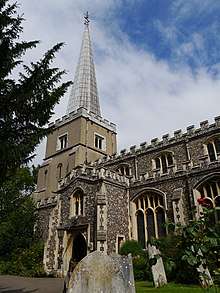
Some of the major churches in Harrow include the Grade I listed St Mary's Church, St John's Greenhill, All Saints Harrow Weald, Holy Trinity Wealdstone, Christ Church Roxeth, and Kenton Methodist Church.
Harrow has a Hindu temple dedicated to Sri Lord Ayyappa and is known as Sri Ayyappan Kovil, located in the Wealdstone neighbourhood. In the same area is the large Harrow Central Mosque, and a smaller local mosque, Masjid Imam Muqbil, is located in South Harrow. On Bessborough Road in the town is the Mosaic Reform Synagogue, and there is a United Synagogue in the Kenton part of Harrow. There is a Zoroastrianism centre in Rayners Lane.
Media
The 1918 novel The Return of the Soldier is based in Harrow.[76]
The wedding of characters Peggy Mitchell and Frank Butcher of EastEnders in 1999 was filmed in Harrow.[77] The classroom in Harry Potter and the Philosopher's Stone was filmed at the Fourth Form Room of Harrow School. The school was also used to shoot many scenes of the drama The Crown.[78] The British Asian soap drama Cloud 9 was shot in Harrow in 2013.[79] The exterior of Clark's house in the 2016 film Me Before You was shot in Harrow.[80]
The Harrow Times is a local newspaper for the borough, and formerly the historic Harrow Observer that dates back to the 19th century.
Radio Harrow is a local charity radio that broadcasts from Northwick Park Hospital. Launched in 2015 in its current form, its predecessor Radio Northwick Park had already been broadcasting for four decades before.[81] A student radio called Smoke Radio broadcasts from the University of Westminster campus since 2004.[82]
Sports
Harrow is represented by the association football club Wealdstone F.C., who play in the National League (fifth tier); they are currently based away in Ruislip, having been forced to leave their original stadium in Harrow in 1991. Another local club is Harrow Borough F.C. who are based at Earlsmead Stadium and currently play in the Isthmian League Premier Division (seventh tier).
Harrow Leisure Centre and Harrow Skate Park are located by Byron Park in Wealdstone. There is a golf course at Northwick Park.
Public services
Harrow borough is patrolled by the Metropolitan Police (the territorial police force in Greater London). The service is mainly provided through Harrow Police Station on Northolt Road in South Harrow, and the borough overall has contact points supported by 22 Safer Neighbourhoods teams.[83] Previous police stations at Kirkland House and in Wealdstone have closed down in the 2010s.[84] The borough's basic command unit is combined with the London boroughs of Barnet and Brent.
Harrow is served by Northwick Park Hospital and specialists St Mark's Hospital and Royal National Orthopaedic Hospital (in Stanmore), which are run by National Health Service. The local Harrow CCG manages public provision of homecare throughout Harrow which is state funded.[85] A private hospital called Clementine Churchill is located in Harrow-on-the-Hill.
Transport
Rail and London Underground
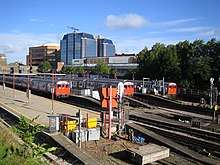
Harrow is served by a number of London Underground and National Rail services:
- Harrow-on-the-Hill (Metropolitan line & Aylesbury Line/Chiltern Railways)[n 1]
- Harrow & Wealdstone (Bakerloo line, London Overground, London Northwestern Railway and Southern)
- West Harrow (Metropolitan line)
- South Harrow (Piccadilly line)
- Rayners Lane (Metropolitan/Piccadilly lines)
- North Harrow (Metropolitan line)
- Kenton (Bakerloo line & London Overground)
- Headstone Lane (London Overground)
- Sudbury Hill Harrow (Chiltern Main Line/Chiltern Railways)
- Northwick Park (Metropolitan line)
- Sudbury Hill (Piccadilly line)
Harrow-on-the-Hill is the town's central station, located on College Road/Lowlands Road. The station provides direct Underground and rail links to the West End, the City, Uxbridge, and through the Chiltern Hills to Aylesbury. Harrow lies roughly halfway between central London and the foot of the Chilterns. The other major station is Harrow & Wealdstone, a short distance north from town, which has direct trains to the West End, Croydon, Gatwick Airport, Watford, Hemel Hempstead and beyond towards Brighton and Birmingham respectively. Both stations are in Travelcard zone 5. Trains towards High Wycombe are served by the smaller Sudbury Hill Harrow station which also provides an alternative route towards the West Midlands.
Harrow-on-the-Hill is a much busier tube station compared with the town's other principle station, Harrow & Wealdstone, recording over 10.3 million London Underground passengers in 2018/2019. However, the latter is served more extensively by National Rail services, as well as the London Overground and because of this it's a busier National Rail station.
A short railway line called the Stanmore branch line used to run from Harrow & Wealdstone via Belmont to Stanmore Village, but this line was closed in 1964.[86]
On 23 December 1991 the IRA exploded a bomb on a train at Harrow-on-the-Hill station; there were no injuries.
Bus
.jpg)
Harrow bus station is adjacent to St Anne's shopping centre and Harrow on the Hill railway station.[87] All buses are managed by Transport for London and links are provided to areas as far as Ruislip, Watford, Edgware, Northwood, Golders Green, Wembley, Ealing, Hayes and Heathrow Airport. Many local buses have a H-prefix in the range 9-19.
During the privatisation of London bus services, Harrow was one of the first places with its own London Regional Transport operating unit, called Harrow Buses and operating from November 1987 in red and cream branded livery.[88] The scheme was not successful and the service gained the nickname "Harrowing Buses" from the local press.[89]
Harrow was the place where the first major electronic contactless smart card technology was being tested on buses. In a £2 million trial that started in February 1994,[90] cards were provided by London Transport at the bus station and could be used on 21 bus routes in Harrow, the largest trial of its kind in the world. Within two months, 9,000 smart photocards were issued. The scheme was a success by the time it ended in December 1995, and led to the development of the Oyster card in 2003.[91]
Road
There are no trunk roads in the vicinity of Harrow. The A312 road starts in Harrow as Bessborough Road - however the A312's section in Harrow is merely an urban road, and the primary trunk road starts over 3 miles away in Northolt. It is here where there is a crossing with the A40 Western Avenue. The A406 is 5 miles away via Neasden, Wembley or Hanger Lane Gyratory. There is access to junction 2 of the M1 motorway 6 miles away via the A41 in Edgware.
Gallery

 St Anns Road
St Anns Road St Anns Road
St Anns Road Middle section of Station Road, showing shops and the Time Building and apartments on Lyon Road behind it
Middle section of Station Road, showing shops and the Time Building and apartments on Lyon Road behind it Harrow's central bus station
Harrow's central bus station Former Fat Controller pub, closed in 2010[93]
Former Fat Controller pub, closed in 2010[93]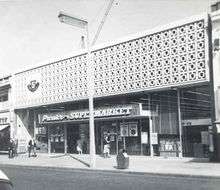
.jpg) Moon on the Hill pub
Moon on the Hill pub
Notable people
Notes and references
- Notes
- Not in Harrow on the Hill, as close to the foot of the hill and long outside of its ward boundary.
- References
- Harrow is made up of 13 wards in the London Borough of Harrow: Greenhill, Harrow on the Hill, Harrow Weald, Headstone North, Headstone South, Kenton East, Kenton West, Marlborough, Rayners Lane, Roxbourne, Roxeth, Wealdstone, and West Harrow. "Archived copy". Archived from the original on 22 February 2014. Retrieved 9 June 2014.CS1 maint: archived copy as title (link)
- Wells, John C. (2008), Longman Pronunciation Dictionary (3rd ed.), Longman, p. 368, ISBN 9781405881180
- http://patfield.com/heathfield/HeathfieldCentenary.pdf
- Forrest, Adam (10 September 2015). "Metroland, 100 years on: what's become of England's original vision of suburbia?" – via www.theguardian.com.
- https://www.allsop.co.uk/resources/2019/04/Next-Harrow.pdf?x89233
- Room, Adrian: "Dictionary of Place-Names in the British Isles", Bloomsbury, 1988. ISBN 0-7475-0170-X
- Briggs, Keith "Harrow", Journal of the English Place-name Society, volume 42 (2010), 43–64
- "Harrow, including Pinner : The growth of the hamlets | British History Online". www.british-history.ac.uk.
- "St. John the Baptist, Greenhill: Sheepcote Road, Harrow".
- "Harrow, including Pinner : The growth of the hamlets | British History Online".
- "Church of St John the Baptist, Greenhill, London".
- "Focus on Harrow: Why this north west London suburb is popular with families and first time buyers". 24 June 2016.
- "St Johns Harrow » Our History".
- "Harrow on the Hill | Hidden London".
- "Harrow, including Pinner : Social history | British History Online".
- Travers, Tony (24 November 2015). London Boroughs at 50. ISBN 9781785900112.
- Walter, Don (15 October 2015). Harrow Through Time. ISBN 9781445637426.
- https://www.harrow.gov.uk/downloads/file/26937/characterisation-study-of-harrow-2011
- Gayler, Hugh J. (1996). Geographical Excursions in London. ISBN 9780761803287.
- Online, Harrow (31 August 2016). "Metro-land: The Birth of Modern Harrow".
- "Accident at Harrow on 26th November 1870 :: The Railways Archive". Retrieved 16 November 2016.
- "1952: Many die as three trains crash at Harrow". BBC News. 8 October 2002. Retrieved 23 September 2018.
- "Where Did The First Bomb Of The Second World War Strike London?". Londonist. 11 January 2017.
- "August 19th - August 24th 1940". www.battleofbritain1940.net.
- "Election 2017: Gareth Thomas, 20-year guardian of Labour progress in multicultural Harrow West, has a hard survival fight on his hands". 31 May 2017.
- "Arrange meetings with councils and public bodies to discuss development sites in London - Sitematch".
- "Gort Scott wins planning for Harrow Council's 'centrepiece' civic centre".
- "'Katie' statue celebrates 25 years anniversary".
- "Watch Princess Diana Opens St Ann's Shopping Centre 1987".
- "George and Ann, A Brief History". 8 May 2018.
- "Back in 1996, St George's Shopping Centre Was Very Different!". 27 March 2019.
- http://docs.novaloca.com/26_6641_636886061704610000.pdf
- "Potted History". 13 August 2011.
- "Football: Wealdstone's tale of woe: Non-league notebook". 16 October 1992.
- https://www2.harrow.gov.uk/(S(z0uow4nqytullvzho2gzihuz))/documents/s68659/Harrow%20Town%20Centre%20-%20Station%20Rd%20Project%20Appendix%20C.pdf
- "Bradstowe House 'eyesore' on verge of sale".
- https://nanopdf.com/downloadFile/agenda-16-03-16-harrow-council_pdf
- Proctor, Ian (27 February 2013). "Morrisons' Harrow store opens at 9am on March 11". getwestlondon.
- http://www.fraser.hk.com/images/exhibition/fact_sheets/harrowsquare_factsheet.pdf
- "Topping out ceremony at Harrow Square". The Hyde Group.
- "'It looks like a load of old shoeboxes' - campaigners say new homes will ruin view".
- "Town centre to get 'bigger and better' library".
- "Concerns raised over conversion of office blocks into flats".
- "The Hub Harrow".
- "'Pop-up restaurant' to act as test bed for future food businesses".
- "Art Deco cinema in north London could be restored to former glory". 14 August 2019.
- "Developer to restore cinema's 1936 art deco façade".
- https://www2.harrow.gov.uk/documents/s108616/HarrowandWealdstoneAreaActionPlan.pdf
- Harrow Core Strategy Final
- Mills, A., Dictionary of London Place Names, (2001)
- Wink, Bri (25 January 2017). "Neighbourhood Guide: Harrow on the Hill". International Student Blog |. Retrieved 19 June 2019.
- Hibbert, Christopher; Weinreb, Ben; Keay, Julia; Keay, John (2008). The London Encyclopaedia. ISBN 9781405049245.
- "Harrow – Store 406". 14 October 2019.
- https://www2.harrow.gov.uk/documents/s139609/Revised%202-01%20-%20Agenda%2019-10-16%20-%20322%20Station%20Road%20-%20P-3489-16.pdf
- https://www.london.gov.uk/sites/default/files/the_london_plan_malp_march_2016_-_annex_2_-_londons_town_centre_network.pdf
- https://www.london.gov.uk/sites/default/files/gla_migrate_files_destination/LB%20Harrow%20slidepack.pdf
- https://www.london.gov.uk/sites/default/files/gla_migrate_files_destination/2013%20TCHC%20report.pdf
- https://www2.harrow.gov.uk/(S(1bwain55pptpzair2v30wdir))/documents/s1402/item%2011%20-%20Town%20Centre%20Strategy%20Appendices%20Plan.pdf
- https://www.gra.world/wp-content/uploads/2015/12/02/00002208.pdf?x18661
- https://content.knightfrank.com/research/1359/documents/en/retail-news-issue-7-the-high-street-redundant-relevant-or-resurgent-5017.pdf
- "Knight Frank's high street retail ranking - where's hot, where's not?". www.knightfrank.co.uk.
- Kalka, Iris (14 May 1986). "A case study of urban ethnicity: Harrow Gujaratis" – via etheses.lse.ac.uk.
- https://airdrive-secure.s3-eu-west-1.amazonaws.com/london/dataset/ward-profiles-and-atlas/2015-09-24T14%3A21%3A13/ward-profiles-excel-version.xls?X-Amz-Algorithm=AWS4-HMAC-SHA256&X-Amz-Credential=AKIAJJDIMAIVZJDICKHA%2F20200328%2Feu-west-1%2Fs3%2Faws4_request&X-Amz-Date=20200328T153411Z&X-Amz-Expires=300&X-Amz-Signature=1f966cd3587c2c44e1fe77ebf84377b94a64ce6809270c5c8cedb9eba7ef7255&X-Amz-SignedHeaders=host
- "Neighbourhood statistics". Office for National Statistics.
- Census Information Scheme (2012). "2011 Census Ward Population Estimates". Greater London Authority. Retrieved 30 January 2013.
- "European Education Briefing Memo - September".
- "AIM25 text-only browsing: University of Westminster: Harrow College of Higher Education and predecessors". aim25.com.
- London, My (3 June 2008). "Pupils go back to school - 41 years after it shut". getwestlondon.
- "New art gallery opens in Harrow". Archived from the original on 4 September 2012.
- "All the news from Harrow – getwestlondon". Retrieved 16 November 2016.
- "Lifestyle: lifestyle news for West London – Get West London". Retrieved 16 November 2016.
- "Granada Harrow Wurlitzer".
- "ABC Harrow in Harrow, GB - Cinema Treasures".
- "Harrow's Hidden Art Deco Masterpiece". 30 October 2015.
- "Plans to restore 1936 art deco cinema façade approved".
- Barlow, Nigel (17 April 2018). "Hope Mill Theatre in Manchester announces final two musicals of 2018 - including UK premiere of Broadway show".
- "BBC News | Entertainment | Frank and Peggy tie the knot". news.bbc.co.uk.
- "Eventopedia | Event Venues, Meeting Rooms & Event Planning". www.eventopedia.com.
- Proctor, Ian (28 March 2013). "New British Asian soap opera filmed in Harrow". getwestlondon.
- "Me Before You".
- "Hospital turned community radio station celebrates 45 years of Harrow broadcasting". This Is Local London.
- "Smoke Radio". Student Radio Association. 3 August 2014.
- "Home | The Met". www.met.police.uk.
- https://maps.met.police.uk/SysSiteAssets/foi-media/metropolitan-police/disclosure_2017/october_2017/information-rights-unit---a-list-of-police-stations-closed-since-2010-broken-down-by-year
- https://www.harrowccg.nhs.uk/download.cfm?doc=docm93jijm4n10592&ver=24154
- "The Harrow and Stanmore railway". www.stanmoretouristboard.org.uk. The Stanmore Tourist Board. Archived from the original on 7 February 2018. Retrieved 7 February 2018.
- "St Anne's, How to find us".
- "THE BIG RED BUS DEBATE | 20th October 1988 | The Commercial Motor Archive". archive.commercialmotor.com.
- "The R. J. Waterhouse Web Site - Leyland Nationals". www.users.globalnet.co.uk.
- "'Smart card' bus tickets go on trial". The Independent. 16 February 1994.
- Badstuber, Nicole (28 August 2018). "Get smart! How a 90s bus pass trial transformed London travel" – via www.theguardian.com.
- Walter, Don (15 October 2015). Harrow Through Time. ISBN 9781445637426.
- https://www.mylondon.news/news/local-news/fat-controller-hits-financial-buffers-5999296
- http://cinematreasures.org/theaters/30140

